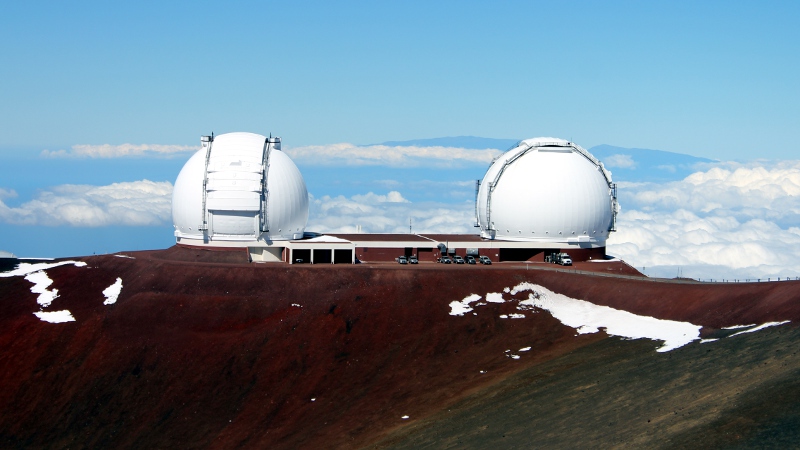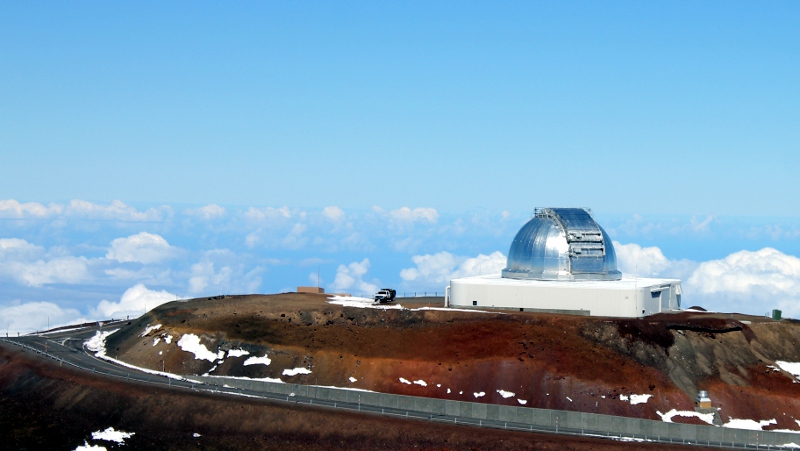
Standing at 13,796 feet, the summit of Big Island’s Mauna Kea is the highest point in the state of Hawaii as well as the central pacific. With its last eruption more than 4,600 years ago, Hawaii’s most recoginized mountain is now home to some of the most technologically advanced astronomy equipment on the planet. Until 1967 no roads to the summit existed, but today all you need is a 4 wheel drive vehicle to climb to the very top of Hawaii.
The best place to begin your trip to the top is at the Onizuka Center for International Astronomy Visitor Information Station on Mauna Kea. This is accessed via saddle road from either Waimea or Hilo. There is a clearly marked turnoff from Saddle road that leads up the mountain. Here you drive through ancient lava country with very little vegetation around. The visitor’s center is located at 9,300 feet, 20 minutes from the turnoff, and provides great resources for those interested in astronomy and the history of Mauna Kea. All vehicles may access the visitor’s center, but only 4 wheel drive vehicles are allowed to continue to the summit. There is no gas anywhere on the mountain, so make sure you have enough to get back to either Hilo or Waimea before you drive to the top.
Mauna Kea is one of the only places in the world where one can drive from sea level to 14,000 feet in just a couple of hours, and because of this altitude sickness is a high possibility. At 14,000 feet, there is 40% less oxygen than at sea level, so it’s recommended that you acclimatize yourself to the elevation at the visitor’s center for a while before continuing up to the top. The Visitor’s center has quite a lot to offer. There are always scientists and volunteers inside eager to answer questions, every night a free stargazing program is offered beginning at 6pm, and outside there are high-powered telescopes to look through. For those interested in Astronomy, you’ll have plenty to occupy your time here.

300 yards beyond the visitor’s center the pavement ends and turns to steep gravel road that leads to the summit observatories. As you drive you’ll climb above the clouds. The views from this road on a nice day are nothing short of amazing. Here is the domain of the Mauna Kea Silversword, one of the rarest and most beautiful Hawaiian plant species. Related to sunflowers, Silverswords are unique to the mountain they live on. There are three varieties, each living on one of the three highest mountains in the state: Mauna Loa, Mauna Kea, and Haleakala. The Mauna Kea access road is the only place on the big island where these extremely endangered plants can be viewed easily by the public (the plants have cages around them to protect them), all other Silversword sites are remote and either closed off or inaccessible. These plants bloom once a year, sending up a flower stalk up to 6 feet tall when germinating. The Silverswords are definitely worth a look.
The observatories at the summit are private facilities and therefore closed to the public, however on the weekends a free guided tour takes visitors inside one of the summit telescopes. The tour leaves as a caravan (you must have your own 4wd vehicle) at 1pm (it’s best to arrive early) from the visitor’s center on Saturdays and Sundays.
There are a plethora of guided tours to the summit to choose from in Hilo, Kona, and Waikoloa, so if you prefer to ride rather than drive, there are many options. For those who prefer to go on their own, there is a small hike from the parking lot at the top to the true summit. In winter there may be snow up here, and at the summit it’s always cold, so make sure to bring warm clothing if you plan on spending more than 20 seconds outside your car.
The summit hike is short. 5-10 minutes at most, but you may be so enamored with the view that you choose to stay for a while.
Mauna Kea is one of the best sites in the world for astronomical observation and its observatores are known around the world for the discoveries they’ve been used to make. A trip up the mountain will take you to one of the most remote places on the planet and provide you with a view you won’t soon forget.
